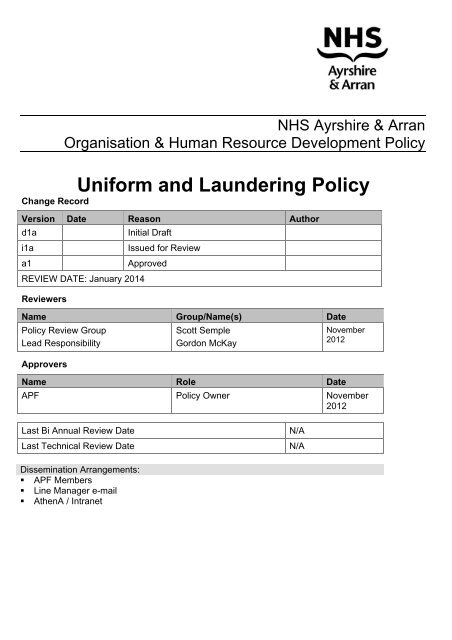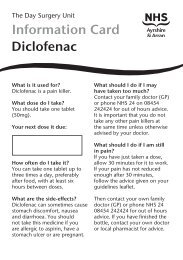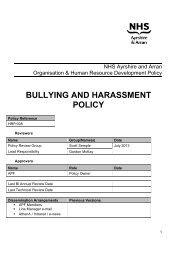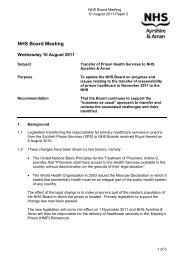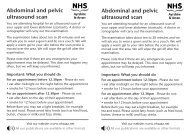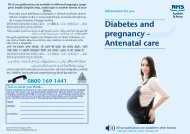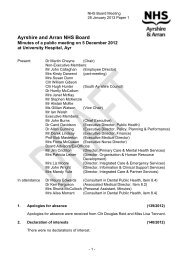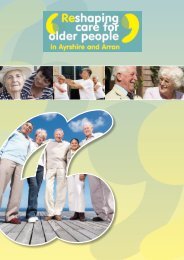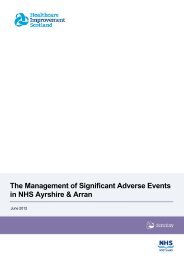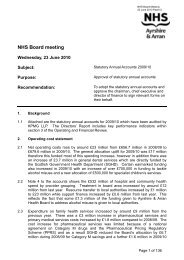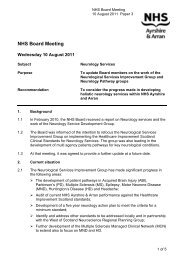Uniform and Laundering Policy - NHS Ayrshire and Arran.
Uniform and Laundering Policy - NHS Ayrshire and Arran.
Uniform and Laundering Policy - NHS Ayrshire and Arran.
Create successful ePaper yourself
Turn your PDF publications into a flip-book with our unique Google optimized e-Paper software.
Is this a new policy?If ‘yes’ why is it required?i.e. to satisfy best practice/complywith new legislationIf ‘no’, name of previous policy <strong>and</strong>reason for replacementNo<strong>Uniform</strong> <strong>Policy</strong>Summary of Substantive Changes MadeSection:<strong>Policy</strong> reviewed <strong>and</strong> drafted in accordance withthe national circular CEL 42 (2010) National<strong>Uniform</strong>, Dress Code <strong>and</strong> <strong>Laundering</strong> <strong>Policy</strong>Summary of Technical Changes MadeSection:N/A
Contents1. Purpose Page 42 Scope Page 43. Accountability Page 44. Responsibility Page 44.1 Head of Department/Line Managers/Supervisor4.2 Staff5. <strong>Uniform</strong> colours <strong>and</strong> shades Page 55.1 The Clinical team5.2 The Non-clinical team5.3 Trousers5.4 Polo shirts5.5 <strong>Uniform</strong> for Students6. Operational Procedure Page 66.1 Issue6.2 Replacement6.3 Recovery on Termination of Employment7. <strong>Laundering</strong> Procedure Page 77.1 M<strong>and</strong>atory Laundry Service Users7.2 Optional Laundry Service Users7.3 Staff outwith7.4 <strong>Uniform</strong> <strong>and</strong> Infection Risk7.4.1 Laundry Classification8. Review <strong>and</strong> Monitoring Page 8Guidance Note 1- <strong>NHS</strong>SCOTLAND Dress CodeAppendix 1 – <strong>NHS</strong> Scotl<strong>and</strong> National <strong>Uniform</strong> SpecificationAppendix 2 – <strong>Uniform</strong> <strong>Laundering</strong> ProcedureAppendix 3 – Contaminated <strong>Uniform</strong> <strong>Laundering</strong> ProcedureAppendix 4 – Home <strong>Laundering</strong> of <strong>Uniform</strong>sAppendix 5 – Staff <strong>Uniform</strong> Contingency <strong>Arran</strong>gementsAppendix 6 – Authorisation/Measurement Form
1. PurposeThe <strong>NHS</strong> <strong>Ayrshire</strong> & <strong>Arran</strong> <strong>Uniform</strong> <strong>Policy</strong>, Dress Code <strong>and</strong> <strong>Laundering</strong> <strong>Policy</strong> has been writtenin line with <strong>and</strong> to meet the requirements of CEL 42 (2010) National <strong>Uniform</strong>, Dress Code <strong>and</strong><strong>Laundering</strong> <strong>Policy</strong>.2. ScopeThe <strong>Uniform</strong> <strong>Policy</strong> is applied throughout the organisation in all areas where uniforms have beenidentified, through risk assessment, to be necessary for reasons of infection control, clinicalrequirements, moving <strong>and</strong> h<strong>and</strong>ling activities, the risk of violence <strong>and</strong>/ or aggression, or securityneed. The <strong>Policy</strong> applies to all approved uniforms worn within the organisation.<strong>NHS</strong> <strong>Ayrshire</strong> & <strong>Arran</strong> will endeavour to provide uniforms that are fit for purpose. Should amember of staff encounter difficulties in implementing any aspect of this policy, for belief or otherpersonal reasons, these should be discussed at the first opportunity with their line manager.3. AccountabilityThe Head of Clinical Support Services - East is the responsible Senior Manager within theorganisation for the oversight of the <strong>Uniform</strong> <strong>Policy</strong>, Dress Code <strong>and</strong> <strong>Laundering</strong> Procedure,however implementation of this policy lies with Line Managers.The uniforms issued to staff remain at all times the property of <strong>NHS</strong> <strong>Ayrshire</strong> & <strong>Arran</strong>.4. Responsibility4.1 Head of Department/Line Managers/SupervisorsHeads of Department/Line Managers/Supervisors shall, for all staff failing within their remit whoare required to wear an approved uniform, ensure that:Suitable <strong>and</strong> appropriate uniform is provided in line with <strong>NHS</strong>Scotl<strong>and</strong> National <strong>Uniform</strong>Specification/<strong>Policy</strong>. Reference – CEL 42 (2010) which can be found on the DomesticServices Athena site under ‘Staff <strong>Uniform</strong>s’.<strong>Uniform</strong>s are made available to staff in sufficient numbers <strong>and</strong> used in accordance withdepartmental requirements.Records are maintained in respect of the following:- the results of uniforms/manual h<strong>and</strong>ling assessments- actions taken as a result of uniforms/manual h<strong>and</strong>ling assessments- information given to employees regarding use of uniforms- complaints or reports of discomfort, or non-suitability of the uniforms <strong>and</strong> theirintended useAll staff have a sufficient number of uniforms to allow a clean uniform to be worn eachworking day <strong>and</strong> a provision for changing during a shift should there be body fluidcontamination. All staff who are required to have uniforms cleaned on a m<strong>and</strong>atory basis (see section 3)via the <strong>NHS</strong> <strong>Ayrshire</strong> & <strong>Arran</strong> <strong>Laundering</strong> Facilities follow the relevant launderingprocedures detailed in Appendix 2 <strong>and</strong> must utilise staff changing facilities provided.
All staff who are not m<strong>and</strong>atorily bound to utilise the <strong>Laundering</strong> Facilities for cleaning(see section 3) <strong>and</strong> exercise the option to launder outwith the organisation’s facilitiesfollow the "Home <strong>Laundering</strong> Guidelines" in Appendix 4 <strong>and</strong> must utilise staff changingfacilities provided.All staff comply fully with the requirements detailed within Section 2.4.2 of the <strong>Policy</strong>"Staff Responsibilities".That all staff who are currently required to wear a uniform are provided with theappropriate national uniform.4.2 StaffAll staff who are required by <strong>NHS</strong> <strong>Ayrshire</strong> & <strong>Arran</strong> to wear an approved uniform whilst in theemployment of the organisation must ensure that:<strong>Uniform</strong>s are worn at work <strong>and</strong> are not used for any other purpose.Permission to wear "mufti" (ordinary clothes) within particular staff groups must beformally authorised by the Head of Department/Line Manager following consultation withthe Head of Occupational Health <strong>and</strong> Safety <strong>and</strong> Infection Control Advisers. Whereapproved "mufti" is being worn, the organisation shall not accept responsibility fordamage due to negligence by an individual to any item of personal clothing<strong>NHS</strong> <strong>Ayrshire</strong> & <strong>Arran</strong> will hold staff responsible for any damage to their uniforms due totheir negligence.Laboratory coats must not be worn outwith the confines of the Laboratories, except atclinics or wards when the member of staff must change their coat before leaving theLaboratory.Scrub suits that are worn in theatre must not be worn outwith the confines of theTheatre complexes except in emergencies.If required, staff members shall wear approved maternity uniforms.In addition to the organisation’s identity badge, a maximum of a further 2 professionalassociation or trade union badges may be worn.In the event of the labelling becoming illegible, staff must alert the local Sewing Roomwho will arrange for the uniforms to be re-labelled. On transfer betweenhospitals/locations the staff member shall make arrangements for their uniforms to bere-labelled via the local Sewing Room/Staff Changing Area/Autovalet at their new base,prior to sending for laundering.5. <strong>Uniform</strong> colours <strong>and</strong> shadesThe purpose of the uniform colour coding is to make it easier for patients, members of the public<strong>and</strong> staff to identify the different roles played by staff. Clinical staff will wear blue <strong>and</strong> nonclinicalstaff will wear green. It must be noted however, that the colour coding is not the onlymeans of communication <strong>and</strong> it is expected that verbal communication <strong>and</strong> staff identifiers willstill play their part.
5.1 The Clinical teamClinical staff will wear a uniform in one of the shades of blue as detailed in Appendix 1.5.2 The Non-clinical teamNon-clinical staff, who currently wears a uniform will wear the mid-green national uniform asdetailed in Appendix 1.Non-clinical staff groups include Catering, Domestic, Porters, Admin & Clerical <strong>and</strong> Facilitiesstaff.Please note the dark green uniform is only for Catering <strong>and</strong> Domestic supervisors <strong>and</strong> must notbe used to denote supervisors or managerial roles in any other staff groups.5.3 TrousersNavy blue trousers are available in a unisex cargo style <strong>and</strong> ladies <strong>and</strong> gents tailored style.5.4 Polo shirtsPolo shirts are available to order as an alternative to tunics, which will be determined by theHead of Department. However, staff who currently wears a tunic will continue to do so.5.5 <strong>Uniform</strong> for studentsNursing <strong>and</strong> Allied Health Professional (AHP) students will wear the national student uniform.This is a silver-grey tunic in the same style <strong>and</strong> fabric as the national uniform for staff. This willbe worn with the national uniform navy blue cargo trousers. The tunic will be embroidered withthe appropriate University/College logo.The national student uniform does not apply to medical students (Doctors <strong>and</strong> Dentists).Medical students are not included in the National <strong>Uniform</strong> policy. The national uniform forstudents is not intended for employees who are undertaking study or training.6. Operational ProcedureThe undernoted procedures should be read <strong>and</strong> applied as appropriate in conjunction with theother procedures detailed within the <strong>Policy</strong>.6.1 IssueThe Domestic Services Department (<strong>Uniform</strong> Distribution) based at <strong>Ayrshire</strong> Central Hospitalshall hold a stock of a limited range of each garment.The Head of Department/Line Manager/Supervisor shall arrange for any new staffmembers to visit the local Sewing Room/Staff Changing Area/Autovalet in order to bemeasured for uniforms. An Authorisation/Measurement Form (Appendix 6) should bebrought with them with appropriate sections completed.It is essential that this process is completed prior to commencement in order thatuniforms are available to staff when starting employment.The <strong>Ayrshire</strong> Central Sewing Room shall despatch the uniforms to the local SewingRoom/Staff Changing Area/Autovalet.At the local Sewing Room/Staff Changing Area/Autovalet uniforms are labelled as per<strong>NHS</strong> <strong>Ayrshire</strong> & <strong>Arran</strong>’s st<strong>and</strong>ard system of labelling.The local Sewing Room/Staff Changing Area/Autovalet shall contact the new member ofstaff to arrange collection of their uniforms.
6.2 Replacement An Authorisation/Measurement Form (Appendix 6) shall be completed <strong>and</strong> signed off bythe Head of Department/Line Manager/Supervisor when replacement uniform is required.Thereafter the process for issuing a ‘new’ uniform will be followed.or<strong>Uniform</strong>s can be retained at local Sewing Room/Staff Changing Area/Autovalet for reissueas bank or stock to be used for staff who may require a clean uniform due tosoilage/contamination (Appendix 5).The <strong>Ayrshire</strong> Central Sewing Room shall despatch the uniforms to the local SewingRoom. The staff member will be contacted to arrange collection of their <strong>Uniform</strong>.6.3 Recovery on Termination of Employment All uniforms issued to staff remain the property of <strong>NHS</strong> <strong>Ayrshire</strong> & <strong>Arran</strong>. The Head of Department/Line Manager/Supervisor shall ask staff to return uniforms tothem.7. <strong>Laundering</strong> ProcedureA clean, well laundered uniform inspires public confidence, sending positive messages aboutour professionalism <strong>and</strong> st<strong>and</strong>ards of care.7.1 M<strong>and</strong>atory Laundry Services UsersStaff who wear scrub suits, Laboratory staff <strong>and</strong> staff who work in Infectious DiseasesUnits are classified as m<strong>and</strong>atory Laundry Service Users <strong>and</strong> as such should follow thelocal <strong>Uniform</strong> <strong>Laundering</strong> procedure (Appendix 2).7.2 Optional Laundry Service UsersThe balance of staff groups who are required to wear uniforms are classified as optionalLaundry Service Users <strong>and</strong> are unable to access the local <strong>Laundering</strong> Facilities <strong>and</strong>consequently take their uniform home to launder as per the Home <strong>Laundering</strong> guidelinesin Appendix 4, with the exception of the undernoted circumstances where use ism<strong>and</strong>atory <strong>and</strong> uniforms must be treated as "infected" linen.7.3 Staff outwithWhere m<strong>and</strong>atory circumstances, as identified above do not apply, staff still required towear a clean uniform to work on a daily basis but can exercise the option to:make external arrangements for the laundering of their uniforms in line with the guidancecontained within Appendix 4.ormake use of the <strong>NHS</strong> <strong>Ayrshire</strong> & <strong>Arran</strong> <strong>Laundering</strong> Facilities in line with the launderingprocedures detailed in Appendix 2.In either case, Heads of Department/Line Managers/Supervisors must ensure that staff areissued with a sufficient number of uniforms to facilitate wearing of a clean uniform on a dailybasis.
7.4 <strong>Uniform</strong> <strong>and</strong> Infection Risk7.4.1 Laundry ClassificationFor laundering classification purposes, 2 categories of uniform have been identified:Used uniformWhere a uniform has been worn in conjunction with appropriate PPE <strong>and</strong> is not visiblycontaminated with blood or body fluids, there is no evidence that it poses any risk tohealthcare workers or the public. Used uniforms can be laundered at home inaccordance with the Home <strong>Laundering</strong> Guidelines (Appendix 4),orWhere available, uniforms can also be laundered in accordance with local <strong>Uniform</strong><strong>Laundering</strong> procedure (Appendix 2).Soiled/Contaminated uniformA contaminated uniform includes a uniform which has become contaminated with bloodor other body fluids, or a uniform which Infection Control advise should be treated ascontaminated. Should a uniform become contaminated, staff should adhere to thefollowing:Contaminated uniforms must be sent to the local laundry facility (Appendix 3). Homelaundering is NOT appropriate for contaminated uniform. Refer to Appendix 5 forcontingency arrangements.Staff are reminded that the risk of cross-infection is minimal from a uniform which has beenproperly protected by the correct use of personal protective clothing. A uniform should beprotected from contamination during health care activity. Plastic aprons should be worn toprotect uniforms from contamination. (Refer to Athena for guidance on PPE within the Health &Safety Manual <strong>and</strong> Infection Control Manual).There is also contingency arrangements in place for mid- shift changes, should a uniformbecome heavily soiled/contaminated. (See Appendix 5).8. Review <strong>and</strong> monitoringThis policy will be monitored <strong>and</strong> reviewed every two years or sooner in light of any legislativechanges or national <strong>NHS</strong> changes.
Guidance Note 1<strong>NHS</strong>SCOTLAND DRESS CODEEvidence-based Principles to inform local policies for StaffThe way staff dress sends messages to the patients they care for, <strong>and</strong> to the public about theirprofessionalism <strong>and</strong> st<strong>and</strong>ards of care.These guidelines reflect evidence-based good practice <strong>and</strong> aim to set out core principles thatshould inform the development of local policy. The following principles are by no means exhaustive,but are intended to give some examples of the issues which Boards should consider. Theseguidelines set out st<strong>and</strong>ards of dress for all staff, including those who do not wear a uniform.In developing local uniform <strong>and</strong> workwear policies, Boards should conduct a full risk assessment toensure that local policy is appropriate for different categories of staff. Boards should look to supportstaff in complying with both the needs of the service <strong>and</strong> any disability, religious or culturalrequirements.Boards must ensure that where appropriate, their dress code policies comply with theseprinciples:‣ Staff must dress in a professional manner which is likely to inspire public confidence; for example: in clean uniform (where uniform is a requirement), which has been launderedin accordance with the <strong>Uniform</strong> <strong>Laundering</strong> <strong>Policy</strong> (Section 3). When providing patient care, hair should be tied back off the collar, with nails kept short<strong>and</strong> clean. Wear clear identifiers (e.g. badges etc). Where changing facilities are available, staff should change into <strong>and</strong> out of uniform atwork <strong>and</strong> should change out of their uniform at the earliest opportunity at the end of theirshift. It is preferable that staff should avoid undertaking activities in public, such asshopping, whilst wearing their uniform, except where such activities form an integral partof their duties.‣ Appropriate steps must be taken to adhere to good practice, <strong>and</strong> to minimise the risks ofinfections <strong>and</strong> cross contamination for patients <strong>and</strong> the public; for example: staff should wear short-sleeved shirts/blouses <strong>and</strong> avoid wearing whitecoats or neck ties when providing patient care; staff may wear full length sleeves whennot engaged in patient care activity; Staff should not wear false nails or h<strong>and</strong> or wrist jewellery (other than a plain weddingring or one other plain b<strong>and</strong>) when providing patient care. Where for religious reasons, staff wish to cover their forearms during patient care activity,it is acceptable to wear disposable over-sleeves where gloves are used, with strictadherence to h<strong>and</strong> <strong>and</strong> wrist washing before <strong>and</strong> after use. Over-sleeves must bedisposed of as disposable gloves. Where for religious reasons, staff wish to cover their upper forearms during patient careactivity, it is acceptable to wear three-quarter length sleeves. Three-quarter lengthsleeves must not be loose or dangling. They must be able to be rolled or pulled back <strong>and</strong>kept securely in place during h<strong>and</strong>-washing <strong>and</strong> direct patient care activity.‣ All appropriate health <strong>and</strong> safety requirements for staff should be met for example: Staff should not wear excessive jewellery; Staff should wear soft-soled, closed toe shoes; Staff should not carry pens or scissors in outside breast pockets.
‣ Staff must dress in a manner which is sensitive to the social, cultural <strong>and</strong> diversity <strong>and</strong>equality needs of other staff, patients <strong>and</strong> carers/visitors.
Appendix 1<strong>NHS</strong> <strong>Ayrshire</strong> & <strong>Arran</strong> <strong>Uniform</strong> SpecificationClinical staffSenior Charge Nurse/midwivesCommunity Team LeadersHospital at Night Practitioners (only incircumstances where there is no SCN on duty<strong>and</strong> they have been designated as Nurse inCharge <strong>and</strong> there is a need for them to be visibleto members of the public as such.)Navy blue tunicNavy blue trousersRegistered Nurses including Dental Nurses Cornflower blue tunic Navy blue trousersAllied Health Professionals (AHP) Mediterranean blue tunic orMediterranean blue polo shirt Navy blue trousers Allied Health Professionals willhave their professional roleembroidered on their tunic/poloshirtHealthcare Scientists, Pharmacy Technicians,Dental Care Professionals including DentalHygienists, Orthopaedic PractitionersAll unregistered staff, support workers <strong>and</strong>trainees Ocean blue tunic or ocean bluepolo shirt Navy blue trousers These staff groups will havetheir professional roleembroidered on their tunic/poloshirt Pale Sky blue tunic or Pale Skyblue polo shirt Navy blue trousers Support staff for Allied HealthProfessionals, HealthcareScientists <strong>and</strong> PharmacyTechnicians can have theirdepartment embroidered ontheir tunic/polo shirt.
Appendix 1 cont/…..Non-clinical staffCatering <strong>and</strong> Domestic staff including nonclinicalstaff traineesMid-green tunicNavy blue trousersCatering <strong>and</strong> Domestic supervisors Dark green tunic Navy blue trousersPorters Mid-green polo shirt Navy blue trousersAdministration <strong>and</strong> clerical staff Plain coloured mid-greenblouse/dress shirt Navy blue trousersSecurity Guard/Head Porter White shirt/blouse (availablewith or without epaulettes) <strong>and</strong>clip on tie with military stylesweatshirt <strong>and</strong> stab vestdepending on local policyBlack trousersA range of outer garments, including cardigans, fleeces <strong>and</strong> shower proof jackets areavailable.Where staff require a heavy duty 3 in 1 water resistant jacket for prolonged use in harshweather conditions, this is considered a specialist item of PPE, <strong>and</strong> is available from theNational Personal Protective Equipment (PPE) contract.
National <strong>Uniform</strong> EmbroideryAppendix 1 cont/…..Tunics <strong>and</strong> polo shirts with the following embroidery will be available to order. It is notpermissible to embroider any other job title or department. It is permissible forunregistered staff to wear the pale blue tunic with no embroidery, <strong>and</strong> this should bedetermined by local policy. Embroidery will only be available on the tunic colours asdetailed below.Mediterranean Blue(Registered AHP staff)Ocean Blue(Qualified Healthcare Scientists, DentalCare Professionals, Pharmacy Technicians,Orthopaedic Practitioners)Pale-Sky Blue(Support staff to AHPs, HealthcareScientists, Pharmacy Technicians,Orthopaedic Practitioners).Embroidery is not required for Dental CareProfessional support staff.PhysiotherapistOccupational TherapistRadiographerPodiatristOrthoptistSpeech <strong>and</strong> Language TherapistOrthotistArts TherapistDieticianProthetistClinical PhysiologistClinical Dental TechnicianDental TechnicianDental HygienistOrthodontic TherapistDental TherapistPharmacy TechnicianOrthopaedic PractitionerPhysiotherapyRadiography *Imaging *PodiatryOrthopticsSpeech <strong>and</strong> Language TherapyOrthoticsArt TherapyDieteticsProstheticsPharmacy* Radiotherapy applies to those working in the 5 Cancer Centre, <strong>and</strong> Imaging is for staffsupporting Radiographers in <strong>NHS</strong> Scotl<strong>and</strong>.
<strong>Uniform</strong> <strong>Laundering</strong> ProcedureAppendix 2The procedures relating to the processing of uniforms for laundering are as undernoted:All staff utilising the <strong>NHS</strong> <strong>Ayrshire</strong> & <strong>Arran</strong>’s Laundry Facilities must place soileduniforms within a yellow linen bag which is available at designated laundrycollection/delivery points.Subsequent to laundering of the uniforms, these will be returned to thedesignated laundry collection/delivery points where local Domestic Services staffwill sort the uniforms <strong>and</strong> place within Staff Changing facilities/Autovalet for staffto collect.Staff must ensure that they utilise this system effectively to ensure that a cleanuniform is available each working day.Where problems occur with the processing of uniforms or the quality of finish, thismust be raised in the first instance with the local sewing room/Staff ChangingFacilities/Autovalet or their Line Manager/Supervisor.Where staff classified as Optional Service Users choose to launder their uniformoutwith the <strong>NHS</strong> <strong>Ayrshire</strong> & <strong>Arran</strong> Laundry Facilities, the guidance detailed withinAppendix 4 must be followed.Staff should make themselves aware of their nearest local laundry collection <strong>and</strong> dropoff point. Designated points for the collection of soiled uniforms/delivery of cleanuniforms are available, these include;Crosshouse HospitalAyr HospitalBiggart Hospital<strong>Ayrshire</strong> Central HospitalHeathfield ClinicAilsa HospitalKirkl<strong>and</strong>side HospitalStaff Changing AreaAutovaletClean:Sewing roomWard LevelCDUCatering departmentLinen StoreWard LevelWard LevelSoiled:Soiled Linen Stores
Appendix 4Home <strong>Laundering</strong> of <strong>Uniform</strong>s GuidanceThis guidance does not apply to theatre scrub suits, any item of PPE, orcontaminated uniforms, for which hospital facility laundries must be used.See Appendix 2 & 3.The following guidance on the home laundering of uniform is for all staff whoare unable to access a local laundry facility or are classified as OptionalLaundry Service Users (see Section 3 of the policy) <strong>and</strong> consequently takeuniform home to launder.SegregationUsed uniform should be kept separate at times from clean uniform.Ensure all items such as pens, coins, tissues are removed from pockets.Apply good h<strong>and</strong> hygiene practice utilising soap <strong>and</strong> warm water beforeh<strong>and</strong>ling clean uniform <strong>and</strong> after h<strong>and</strong>ing soiled uniform.TemperatureAll uniform should be laundered at the highest temperature suitable for thefabric as per the care label <strong>and</strong> guidance below.Caring for Your New <strong>Uniform</strong>Garment Care AdviceMachinetemperatureguideIrontemperature2 spots =mediumDo notbleachDrycleanableTumble drywith low heatDetergentsUse a detergent that is suitable for your skin type.Do not add bleaches to the wash process or use for a ‘whitening’ effect.Tumble Drying/Ironing<strong>Uniform</strong> may be ironed or tumble dried as per the care label <strong>and</strong> guidancebelow.Storage <strong>and</strong> TransportationEnsure laundered uniform is stored separately from used uniform.
Ensure all storage <strong>and</strong> transportation facilities are clean <strong>and</strong> washedregularly.
Staff <strong>Uniform</strong> Contingency <strong>Arran</strong>gementsAppendix 5All staff who are required to wear uniforms <strong>and</strong> are involved in patientcontact should underst<strong>and</strong> the rationale for optimum launderingprocesses. If uniforms are laundered correctly, it will ensure that theuniforms are safe to wear.Contingency arrangements are in place for mid-shift changes, should auniform become heavily soiled, whereby, staff will have access toemergency supplies of uniforms/alternatives <strong>and</strong> can dealappropriately with their soiled uniforms, placing the uniform in a clearbag then into a yellow linen hamper to send to the laundry.These arrangements will extended to student nurses who may not beprovided with <strong>NHS</strong> <strong>Ayrshire</strong> & <strong>Arran</strong> uniforms or may not use thelaundering service.All staff utilising the <strong>NHS</strong> <strong>Ayrshire</strong> & <strong>Arran</strong> Laundry Facilities mustplace soiled uniforms within a uniforms laundry bag which is availableat designated laundry collection/delivery points within each of theHospital sites.Subsequent to laundering of the uniforms, these will be returned to thedesignated laundry collection/delivery points where local DomesticServices staff will place the uniforms within the Autovalet facilities/StaffChanging facilities for staff to collect.
Appendix 6SAMPLE FORM ONLY – Forms available in triplicate sets through Stock ItemProcurementSTAFF UNIFORMSAUTHORISATION / MEASUREMENT FORMSURNAME ……………………………………...……………………………………………….DESIGNATION ………………………………………………...................DEPARTMENT ……………………………………………………………………………………….DATE OF COMMENCEMENT ……………………………………………………………..FORENAME(S)*FULL/PART TIME No. OF DAYSHOSPITALTRANSFER POINT No.REASON FOR ISSUE:-* NEW APPOINTMENT/*PERMANENT/*TEMPORARY/*REPLACEMENT-REASON……………………………...AUTHORISED BY:-NAME …………………………………………………….. DESIGNATION……………………………………………...DEPARTMENT ………………………………………….. HOSPITAL…………………………………………………...SIGNATURE …………………………………………….. DATE…………………………………………………………LOSS CERTIFICATE COMPLETED *YES/NOQUANTITY TYPE OF UNIFORM……………………………..……………………………..………………………….. ...……………………………..……………………………..……………………………..……………………………..……………………………..……………………………..…………………………………………..…………………………………………..…………………………………………..……………SEWING ROOMUSE ONLYMEASUREMENTS:- SIZE ……….. SIZE………..CHEST/BUST ………………………………………………………………………………………WAIST …………………………………………………………………………………………….HIPS ………………………………………………………………………………………………LENGTHINSIDE LEGCOLLAR
ABOVE UNIFORMS ISSUED BY ………………………………………SEWING ROOMDATE …………………………………………………….. SIGNATURE………………………………………………...I CERTIFY THAT I HAVE RECEIVED THE UNIFORMS DETAILED ABOVESTAFF MEMBER’S NAME …………………………….. DESIGNATION……….......................................................DEPARTMENT ………………………………………….. HOSPITAL……………………….........................................SIGNATURE …………………………………………….. DATE…………………………………………………………..(*Delete as appropriate)


